| Please access the following URL if you want to secure using SSL. All pages in the site will be secure pages. |
| https://secure02.blue.shared-server.net/www.fish-food.co.jp/message english 10.2019.html |
Welcome to FISH FOOD TIMES
Oct. 2019 issue No.190

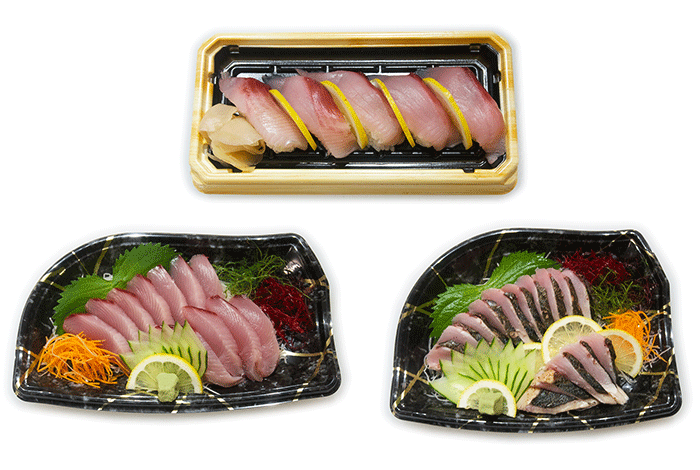
Striped bonito sashimi & sushi
Tsushima warm current of skipjack
After struggling with the words of the headline title, I decided to do so, thinking that the expression "speaking of skipjack in Genkainada Sea, Striped bonito" might be some unreasonableness. Because in the vicinity including Fukuoka City where I first worked on fish decades ago, I rarely saw raw bonito, and speaking of raw bonito, I called striped bonito "skipjack" .
By the way, at that time, speaking of raw tuna rather than big eye tuna or yellowfin tuna, the whole swordfish tuna is called “tuna” and remembers that tuna was not red but orange. If you do such a groundless product indication at this time, it will be suspended due to the suspicion of improper display, but it was quite rough about half a century ago when I was young, and that is imposing It was an era that passed without problems.
Most skipjacks born in the Southern Ocean go up the Pacific Ocean on the Kuroshio Current, so there are very few skipjacks going up on the Tsushima Warm Current on the Japan Sea side, and the skipjack is landed at the fishing port on the Sea of Japan it is not much. However, many striped bonito inhabit the sea area along the Tsushima Warm Current, and many striped bonito are landed in the fishing port along the Tsushima Warm Current including northern Kyushu.
For a long time, striped bonito has been treated in the same way as skipjack in the Sea of Japan side area. For example, the surface of the fish is called tataki by Scolding. In Goto archipelago, there is a eating habit of making and eating smoked namabushi like katuobushi, and this is a local specialty as shown in the image below.
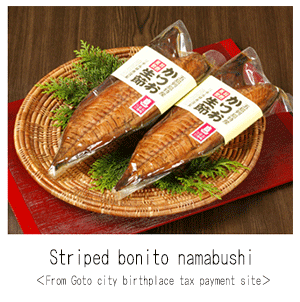
When striped bonito is caught, bullet tuna etc. often enter the net together. As shown in the image below, when fish caught in a stationary net are landed from a fishing boat and thrown out of a seawater box on the floor of a fishery cooperative, not only striped bonito but also bullet tuna and mackerel tuna may be mixed.
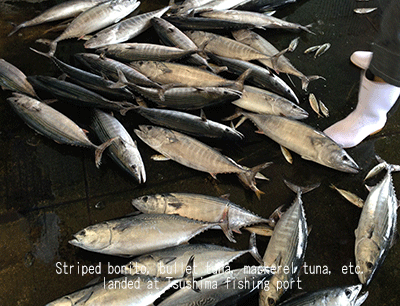
Striped bonito is a mackerel fish classified into the same species as tuna and bonito, and belongs to Sarda Cuvier, one of which is divided into genus Tuna and bonito.

Characteristic in that form is that sharp teeth stand out, and it is also called fox bonito because it resembles fox because of its sharp teeth and elongated face, and there are also areas where the name of line bonito is communicated from the vertical stripes on the back.
By the way, the bullet tuna caught with the striped bonit in the stationary net is the Frigate tuna in the image below. The difference from the similar bullet tuna is that the frigate tuna has a round body but high body height, and the bullet tuna has a low body height and is round, thin and small.

striped bonito is more like this Frigate tuna than skipjack. Striped bonito is not as fat as skipjack, as the slenderness of the fish shows. It tastes relatively light, but it's not bad because it has less fat. As the fat is inconspicuous, it has a delicious taste that can be tasted moderately.
In addition, let's introduce the following images as tips for knowing and distinguishing similar fish.
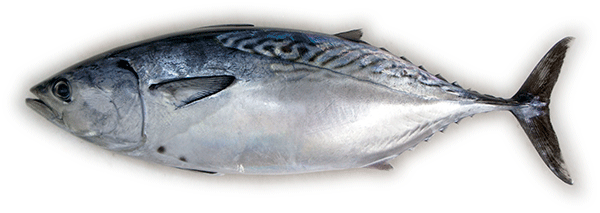
This is mackerel tuna. The mackerel tuna is described in FISH FOOD TIMES March 2016 No.147. Its features are several spots under the chest fins, which are similar to moxibustion and are also called moxibustion bonito.
The difference between mackerel tuna and striped bonito and bullet tuna is that the fish body is shorter than the body height and the fish body is round. This figure shows that this fish is inherently easy to get fat, and Kinki University and Ehime University, which paid attention to this point, worked on aquaculture of mackerel tuna over the years. It seems that they have succeeded in complete aquaculture and have achieved a certain result, and they are about to open the path to mass production.
Is the color of striped bonito not red?
Now, bonito is characterized by a red fish meats color, but striped bonito is not so strong in red. This means that even though the freshness of striped bonito is slightly better, the color of fish meats is easily lost, resulting in the light color of fish meats. In fact, there is still some redness at the wonderful freshness stage.
For example, I think you can understand that if you compare the lower left image, which has been landed for only a few hours, and the lower right image, which has only been several hours since the purchase of the fish, but it is unknown how many hours have passed.
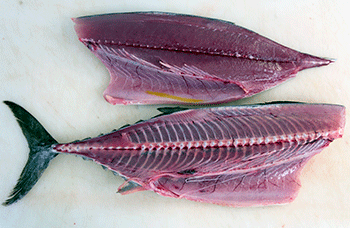
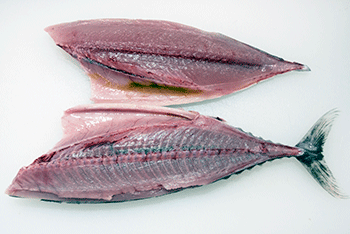
In other words, striped bonito, whose body red color has faded, can be judged to the extent that the color disappears, but that is also a common feature of tuna and bonito. However, the fish meat color of striped bonito is often thought to be the color of the image in the upper right even though it is fresh, but the original bonito has such a red fish meat color I want you to know.
However, it should be prepared that most of the freshness that can be made in sashimi can be expected only in the color of the level of the upper right image in the fish market of the consumption area that is not the production area of striped bonito. It is better to think that the upper left image is possible only in the vicinity of the fishing port where the striped bonito is landed.
In the vicinity of such a fishing port, if you commercialize sashimi using striped bonito, which has excellent freshness, you can make a sashimi product with the following red color.

The striped bonito sashimi with such a good color is not something that can be commercialized everywhere, and it is an exceptional position, so I decided not to use this image as the first page image for this month's issue. Because if this striped bonito is such a red color, it is a freshness level so that you can feel a firmness after death when you eat this striped bonito sashimi, you may change the common sense that the striped bonito is soft It's from the body.
Striped bonito meat is soft
I got this striped bonito in July of a year, and when I opened the belly of this fish, a big egg came out.
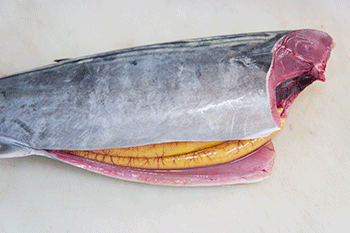
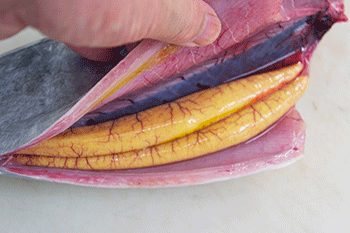
As you can see from this image, striped bonito's laying eggs time is around July, and this fish egg is also a product for sale because it is valuable as a product. Striped bonito, which finished laying eggs by the beginning of summer, will start to store fat to restore the nutrition absorbed by fish eggs, and it will become even more delicious from around October in the autumn, so when striped bonito is delicious Is from autumn to winter.
Tuna and bonito members belonging to the mackerel family generally have soft fish meat. Striped bonito is no exception, and it is not uncommon for fish meat to break and the product value to drop if three pieces disassembling is not successful.
When this striped bonito was made into three pieces disassembling, it became as follows.
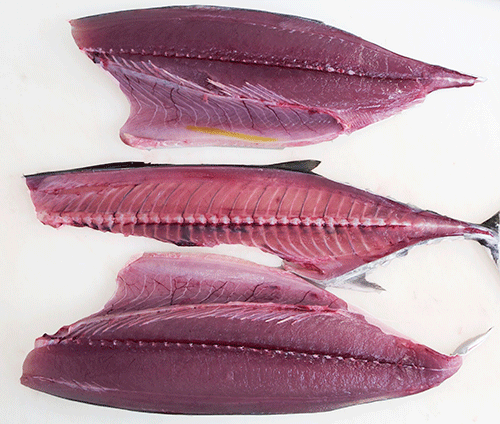
When I was still young, when I was first taught by a senior to striped bonito's three pieces disassembling, I was taught to use yanagiba kitchen knife instead of deba kitchen knife. At that time, I was wondering why yanagiba kitchen knife instead of deba kitchen knife. I was wondering why my seniors use the deba kitchen knife when stripping the red sea bream when using striped bonito and the yanagiba kitchen knife. When I asked that question, no one was able to give a concrete rationale just by saying, “Because this is easier to do…”.
However, after repeating striped bonito's three pieces disassembling over and over again, the question could be solved in my own interpretation. In fact, stripped bonito is hard to break fish meat when dismantled with yanagiba kitchen knife. I understand that the reason why it is hard to break is that yanagiba kitchen knife is less thick than deba kitchen knife, so when I cut open striped bonito of soft fish meat, I don't compress fish meat.
The writer who understood in this way has always used the yanagiba kitchen knife to disassembling three pieces of fish named Bonito until today. For this purpose, the yanagiba kitchen knife has been used for too long, shortening the blade length, repeating the sharpening, and the width of the hard steel of kasumiyaki is narrow and thin, not only the dismantling of bonitos but also the fillet I used it when I made it. It has been treated separately from yanagiba kitchen knife, which emphasizes sharpness for sashimi.
This time, when striped bonito is three pieces disassembling, the special yanagiba kitchen knife is used. However, until the head was dropped, the internal organs were taken out, and the dorsal fin was removed, the deba kitchen knife was used as follows.
| How to remove dorsal fin from striped bonito |
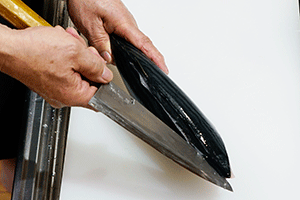 |
| 1,Insert the tip of the deba kithen knife into the lower right corner of wakaremi, the muscle that moves the dorsal fin, and proceed to the head. |
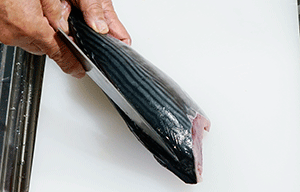 |
| 2,In the same way, make a cut with deba kitchen knife under the wakaremi at the lower left of dorsal fin, and cut toward the head side. |
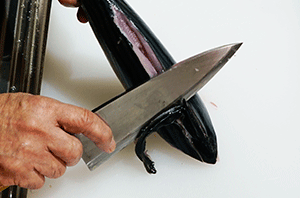 |
| 3,Cut the cutting edge of the deba kitchen knife under the second dorsal fin, and push it toward the head side. |
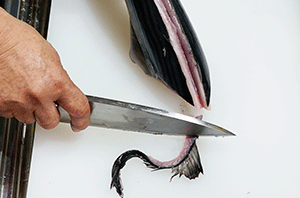 |
| 4,The dorsal fin is removed and separated. |
The next is the process of three pieces disassembling without the striped bonito two pieces disassembling process.
| Three piece disassembling process of striped bonito using yanagiba kitchen knife | |
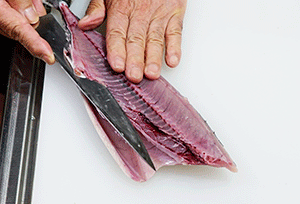 |
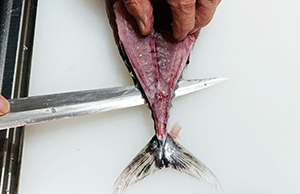 |
| 1,Cut the edge of the yanagiba kitchen knife under the anal fin with centralbone up. | 5,Cut the cutting edge between centralbone and fish meat, and cut it slightly toward the tail. |
 |
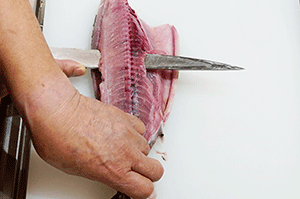 |
| 2,Cut the edge of the kitchen knife to the backbone. | 6,Insert the edge of the yanagiba kitchen knife into the hole where the cut is made with the tip of the knife facing the head, and cut it straight toward the head. |
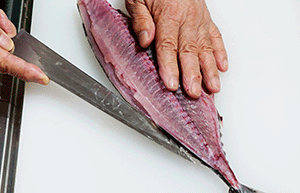 |
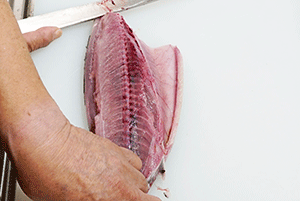 |
| 3,Rotate the head and tail 180 degrees, and cut the edge of the yanagiba kitchen knife into the cut end where the dorsal fin is removed. | 7,Cut to the end on the head side and cut off from the centralbone. |
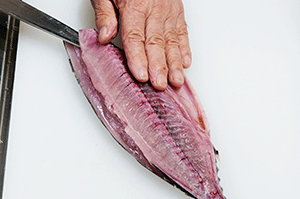 |
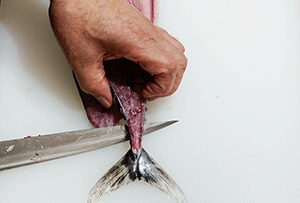 |
| 4,Cut the blade edge to the backbone and cut it toward the head while applying the blade edge. | 8,Finally, cut off the remaining joint near the tail. |
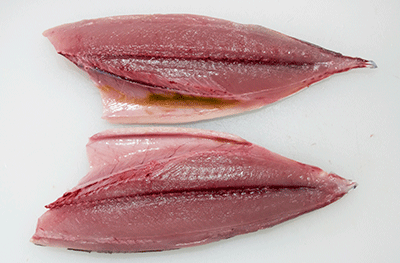 |
|
| striped bonito made into three pieces disassembling using yanagiba kitchen knife | |
If you use a soft striped bonito, using a yanagiba kitcen knife will also reduce the chances of breaking the fish meat and avoid reducing the value of the product.
Increase added value by broiled method
Three striped bonito has been used as a broiling (tataki) and commercialized for a long time, just like skipjack. If the striped bonito fish is relatively small, it is better to beat the three pieces disassembling half as it is, and if you get a big fish, you can use a quarter and broiling, depending on the size of the fish.
| The process of broiling half striped bonito with a small fish body |
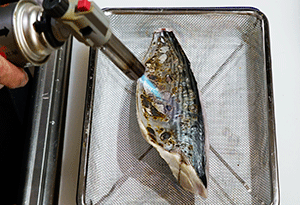 |
| 1,Broiling with a burner on a metal mesh. |
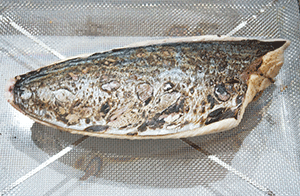 |
| 2,When broiling the skin, be careful not to rupture the broiled round bulge as much as possible. |
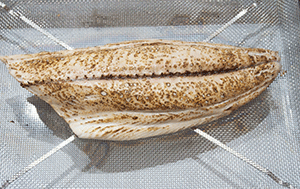 |
| 3,For fish meat, broiling so that the burn marks are even. |
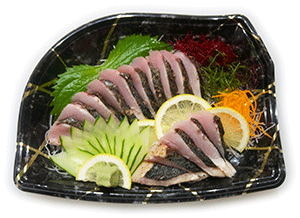 |
| Striped bonito broiling (tataki) using only the back body |
Next, let's introduce the process of broiling a large fish striped bonito into a quarter.
| The process of broiling a relatively large striped bonito into a quarter |
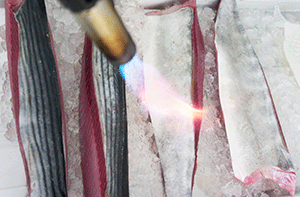 |
| 1,Placing ice in a metal bat with holes, then placing a quarter of striped bonito on it and broiling it will cool the broiled surface with ice. |
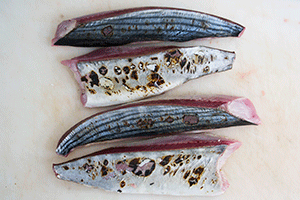 |
| 3,Four quarters of broiled striped bonito |
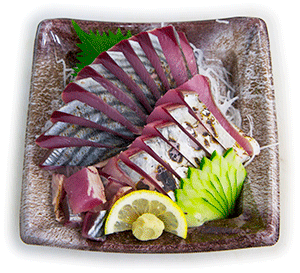 |
| Striped bonito broiled sashimi with back body and belly body |
Skipjack market price
Speaking of the purchase price of striped bonito, this may vary greatly depending on the region, but I think that it is good to keep in mind as a market sense, if the freshness is the same level, striped bonito It is unlikely that the price will be higher than skipjack.
After all, skipjack is basically the main player in terms of mass. Market trends are not only striped bonito but also mackerel tuna and bullet tuna are complementary positions of skipjack, and the market trends of skipjack can be used as reference for price changes of striped bonito.
The following is an article of Minato news paper, September 24, 2019, showing the price transition of fresh fishing skipjack.
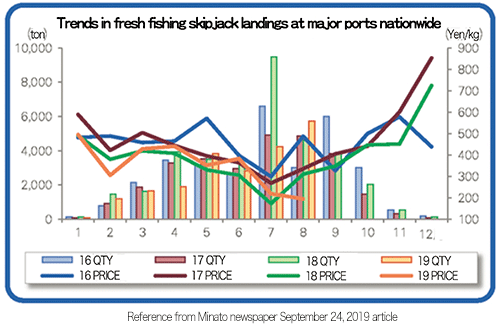
Looking at this graph, we can see that the price of the fresh fishing skipjack has dropped due to the increase in catch in August. Although it is not yet possible to determine what will happen after September, it seems that it can be expected that the price will be easier to handle than usual.
As mentioned above, if striped bonito is not traded at a higher price than skipjack at the same freshness level, this year it may be easier to handle striped bonito, from autumn to winter. I think that it would be good to think about aggressively selling striped bonito, which makes it delicious.
There are many fish named bonito, and I think you understood a little that skipjack is not bonito. Each “bonito” has its own taste, and it is a prejudice that it is not delicious unless it is skipjack, and this month's striped bonito is definitely delicious. For example, mackerel tuna has great expectations as a farmed fish hope in the future, and the affordable size that is not as big as bluefin tuna is easy to handle from the seller side, so it can be an alternative product for bluefin tuna in the future It is a “bonito” that has great potential.
Striped bonito has a strong praise or censure due to regional characteristics, and it seems that it is often treated as a fish for fillet in the Kanto region, but it seems that it is because it has only experience that only striped bonito that has lost freshness has been handled . If you buy fresh striped bonito and try it with sashimi or sushi, the image of striped bonito should change greatly. I hope everyone will also actively sell bonito other than skipjack.
| Please access the following URL if you want to secure using SSL. All pages in the site will be secure pages. |
| https://secure02.blue.shared-server.net/www.fish-food.co.jp/message english 10.2019.html |
An opinion and the communication are to iinfo@fish food times
Date of updating 1 Oct. 2019
